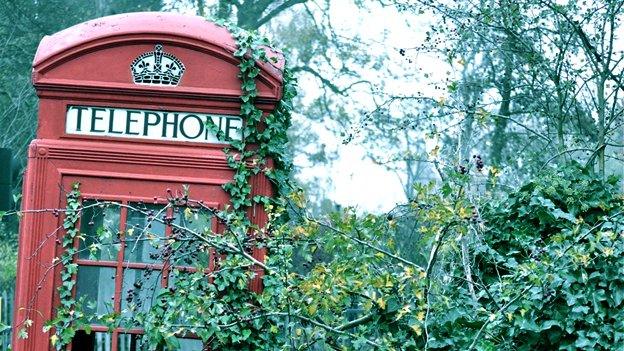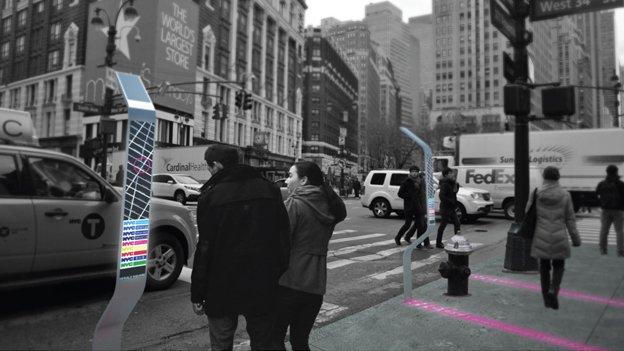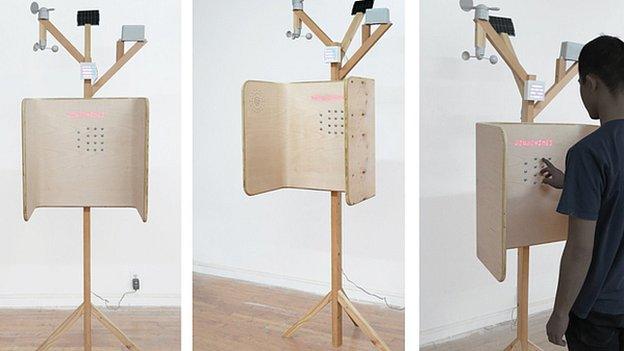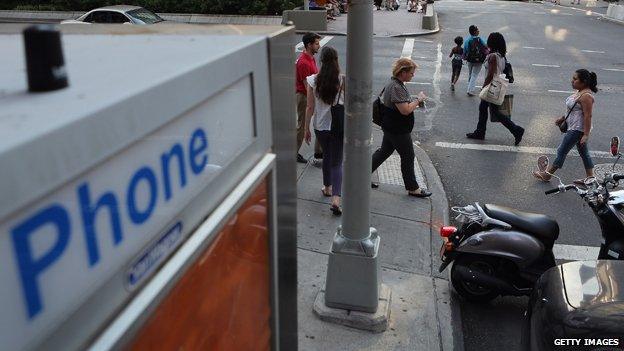New York's phone boxes get new lease of life
- Published

Out of order: Can technology really save the dwindling global phone box population?
The sight of a public phone in many parts of the world is a sad one.
Full of rubbish and covered in graffiti, they stand like a defeated army, crushed by the unstoppable march of the mobile phone.
When American inventor William Gray installed the first public coin telephone at a bank in Connecticut in 1889, he ushered in a new era in public communication.
He also gave Clark Kent somewhere handy to get changed.
Now Superman would almost certainly think twice, while time-travellers Bill and Ted would struggle to have an excellent adventure in one.
'Dynamic city'
The city of New York once had 35,000 phone booths; it is now down to 11,000.
But the city hopes to stop the decline there.

Call me: The public phones at Grand Central Station in New York.
It is due to overhaul its phones in 2014 and has held a Reinvent Payphone challenge.
"New York is the most dynamic city in the world, and while technology has changed all around us, the city's payphones have remained mostly the same for decades," said Mayor Michael Bloomberg.
The competition received 125 physical and virtual prototypes from urban designers, planners, technologists and policy experts.
Judges selected six winners based on connectivity, creativity, visual design, functionality and community impact.
The winner in the best functionality category, Smart Sidewalks, was described as "a 21st Century library without walls".

The Smart Sidewalks prototype is a touchscreen information hub and charging station
The six-inch-wide strip that rises from the pavement - or sidewalk, rather - acts as a touchscreen, wi-fi hub, energy source, charging station and a range of other functions.
But the solar-powered facility goes further, with a ground strip collecting information ranging from wind speed, rainfall and temperature to foot traffic.
This publicly accessible database could help "fundamentally reshape the city", according to the designers.
Shining light
Towering over pedestrians was the winner of best visual design, the Beacon.

Advertising revenue would allow the Beacon's functions to be free
"Gently rising out of the sidewalk", in the words of its creators, this 12-foot behemoth includes a stack of LED matrix screens, similar to those found on Times Square billboards.
The upper screens function as digital signage, bringing in advertising revenues and allowing the Beacon to provide its other functions free.
These screens would also adapt to public events throughout the city, from NYC marathon mileage markers to themed banners, celebrating with the city during its many parades, its creators claim.
The lower screens are dedicated to New York City's local street life and communities, with local advertising and community message boards as well as the telephone.
One benefit is that the tower is controlled by voice and gestures, making it touch-free and hygienic.
Urban farming
A very different approach won a group of students and recent graduates the community impact prize.
Their Windchimes creation is more of a weather station than a phone booth.
These "environmental sensor stations" would use the phone network to offer real-time and hyper-local records of the city's rain levels, pollution and other environmental conditions.

Speakers are embedded on each side of the Windchimes prototype, with a weather station fitted on top
"Imagine Windchimes data helping you plan your bike commute so that the wind is always at your back, tend to your urban farm using microclimate data or care for your asthmatic child with air-quality metrics," its designers ask.
The ideas that got short shrift tended to revolve around a booth that was little more than a giant smartphone - "an iPhone on a stick" in the words of one judge.
Universal access
But as smartphones evolve, the nagging feeling remains that these inventions might soon be relegated to the lonely status of their predecessors.
Tammy Smulders, founder of trends consultancy SCB Partners - and a former resident of New York - says there is something appealing about community hubs.

Some phone booths in NYC already fill other purposes, like this one which is also a wi-fi hotspot
"That said, the cost of maintaining the phone box can be high - keeping them clean and free of undesirable messaging and usage," she says.
"There would be a public cost to refit and modernise phone boxes, and without a clear benefit to society, so I'm not sure there will be a good societal return on investment."
However, Tudor Aw, head of technology for Europe at professional services firm KPMG, disagrees.
"It is important to remember that the primary purpose of payphones is to provide 'universal access' to the less well-off and vulnerable," he says.
"It is easy to forget in today's world of high mobile phone penetration that this objective still holds true.
"Importantly however, universal access should no longer relate to just voice but should also include data," he says.
Christian Nellemann, chief executive of XLN Telecom, a telecoms provider for small businesses, notes that phone boxes have been reinvented worldwide as places to house wi-fi connections.
"In the UK, BT have used their network of phone boxes as Openzone wi-fi hotspots.
"In the developing world, wi-fi carried over existing phone lines will be the only option for downloading large amounts of data for years before 4G mobile reaches outlying areas," he says.
This means the village phone box will be likely to transform into the village wi-fi connection.
But Nelleman notes companies have had less luck finding a use for the physical space of the phone box.
"Perhaps we'll have to wait until teleportation ports are invented before they have another use," he muses.
That thought should keep Bill and Ted happy for the time being at least.